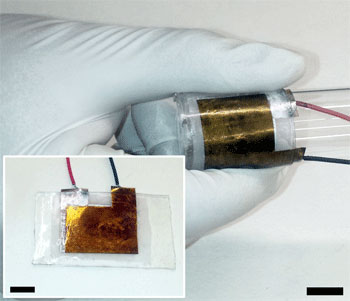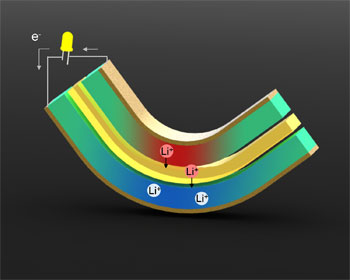New bendy device could power wearable electronics
Tiny generator captures wasted energy with chemistry

One day, people could listen to music from devices powered by their own movements.
william87/istockphoto
People on a busy sidewalk use lots of energy to get from one place to another. But some of that energy gets wasted. Shoes and the pavement absorb this mechanical energy. What if that energy instead could be put to better use?
“Harvesting mechanical energy is vitally important for wearable and portable electronics,” says Zhong Lin Wang. He’s a materials scientist at the Georgia Institute of Technology in Atlanta. A person’s phone, for instance, might be powered by their own movements. But first researchers have to figure out a way to gather that energy.
Sangtae Kim had an idea about how to do that. He’s a materials scientist at the Massachusetts Institute of Technology in Cambridge. He and his colleagues have come up with a way to use chemistry to convert wasted energy into electricity.

In the new device, the electrodes are made of the same material, a mixture of lithium and silicon. And they’re flexible. The electrolyte is sandwiched between them. As the device bends, it compresses the electrode on one side. At the same time, the bending stretches the other electrode. The uneven stresses make ions flow.
“Once we bend the device, lithium really wants to move to the other electrode,” says Kim. But it can only pass through the electrolyte in the form of lithium ions. “So lithium will separate into an electron and a lithium ion,” Kim explains. “And then lithium ions will move from the compressed electrode to the one that is stretched. Those lithium ions have a positive charge.”
The process leaves a lot of lone electrons, each of which has a negative charge. Those electrons want to join up again with the positively charged ions. However, they can’t move through the electrolyte. Instead, the electrons flow through wires that connect one side to the other. That movement is an electric current, and it can power a device. “The flow of electrons is the electricity,” Kim explains.
When the electrons reach the other electrode, they recombine with the lithium ions. That results in neutral lithium atoms.
The device unbends when the pressure is released. Now there’s again an imbalance between the two electrodes. So lithium ions travel back to the uncompressed electrode. And electrons flow through wires to rejoin them.
“This process basically repeats and repeats in reverse directions” as the device is bent and unbent, says Kim. His team reported its work January 6 in Nature Communications.
The inspiration
Kim got the idea for his team’s new invention after reading about a “smart road” project in Italy. That project used the mechanical energy from cars passing on the road to make electricity. It did that with piezoelectric (PEET-zoe-eh-LEK-trik) materials. These are crystals that produce an electric charge when pressure deforms their structure.

Kim’s approach instead harvests energy with chemistry. And it works best with actions that take place more slowly. “It doesn’t have to be regular motion,” he notes. “It can be any slow motion.” For instance, it could be something like walking at a rate of two steps per second.
The ions move relatively slowly in the new method. And that may be one reason why it works well with low-frequency actions, notes Wang, who was not involved in the research. However, he adds, piezoelectric and other types of energy harvesting devices also can work with a range of low to high frequencies.
The new technology “still needs some engineering breakthroughs” before it becomes practical, Kim says. The output from the prototype is only one microwatt per square centimeter. That’s less than a thousandth of the energy needed to light a typical LED light bulb.
Despite the challenges, Kim thinks the technology could one day power personal electronics or run a smart home. Maybe a sidewalk application could even add power to the electric grid.
“Someone might say it’s ambitious, that but that’s sort of the goal that we’re working towards,” Kim says.
Power Words
(for more about Power Words, click here)
atom The basic unit of a chemical element. Atoms are made up of a dense nucleus that contains positively charged protons and neutrally charged neutrons. The nucleus is orbited by a cloud of negatively charged electrons.
battery A device that can convert chemical energy into electrical energy.
chemistry The field of science that deals with the composition, structure and properties of substances and how they interact with one another. Chemists use this knowledge to study unfamiliar substances, to reproduce large quantities of useful substances or to design and create new and useful substances. (about compounds) The term is used to refer to the recipe of a compound, the way it’s produced or some of its properties.
circuit A network of that transmits electrical signals. In the body, nerve cells create circuits that relay electrical signals to the brain. In electronics, wires typically route those signals to activate some mechanical, computational or other function.
crystal (adj.crystalline) A solid consisting of a symmetrical, ordered, three-dimensional arrangement of atoms or molecules. It’s the organized structure taken by most minerals. Apatite, for example, forms six-sided crystals. The mineral crystals that make up rock are usually too small to be seen with the unaided eye.
current A fluid body — such as of water or air — that moves in a recognizable direction. (in electricity) The flow of electricity or the amount of electricity moving through some point over a particular period of time.
electric charge The physical property responsible for electric force; it can be negative or positive.
electric current A flow of charge, called electricity, usually from the movement of negatively charged particles, called electrons.
electricity A flow of charge, usually from the movement of negatively charged particles, called electrons.
electrode (in chemistry) Material that serves as an anode or cathode, attracting negatively or positively charged particles. Or things that serve as electric conductors through which current leaves or enters something else.
electrolytes Minerals that carry electrical charges.
electron A negatively charged particle, usually found orbiting the outer regions of an atom; also, the carrier of electricity within solids.
frequency The number of times a specified periodic phenomenon occurs within a specified time interval. (In physics) The number of wavelengths that occurs over a particular interval of time.
grid (in electricity) The interconnected system of electricity lines that transport electrical power over long distances. In North America, this grid connects electrical generating stations and local communities throughout most of the continent.
ion An atom or molecule with an electric charge due to the loss or gain of one or more electrons.
LED (light-emitting diode) A type of semiconductor device that produces light.
lithium A soft, silvery metallic element used in some batteries, medications and other applications.
materials science The study of how the atomic and molecular structure of a material is related to its overall properties. Materials scientists can design new materials or analyze existing ones. Their analyses of a material’s overall properties (such as density, strength and melting point) can help engineers and other researchers select materials that best suited to a new application.
mechanical Having to do with the devices that move, including tools, engines and other machines (even, potentially, living machines); or something caused by the physical movement of another thing (such as a “mechanical” itch).
molecule An electrically neutral group of atoms that represents the smallest possible amount of a chemical compound. Molecules can be made of single types of atoms or of different types. For example, the oxygen in the air is made of two oxygen atoms (O2), but water is made of two hydrogen atoms and one oxygen atom (H2O).
piezoelectricity An electric discharge, often as a result of subtly deforming a crystal or crystalline material.
prototype A first or early model of some device, system or product that still needs to be perfected.
silicon A nonmetal, semiconducting element used in making electronic circuits. Pure silicon exists in a shiny, dark-gray crystalline form and as a shapeless powder.
technology The application of scientific knowledge for practical purposes, especially in industry — or the devices, processes and systems that result from those efforts.
watt A measure of the rate of energy use, flux (or flow) or production. It is equivalent to one joule per second. It describes the rate of energy converted from one form to another — or moved — per unit of time. For instance, a kilowatt is 1,000 watts, and household energy use is typically measured and quantified in terms of kilowatt-hours, or the number of kilowatts used per hour.







